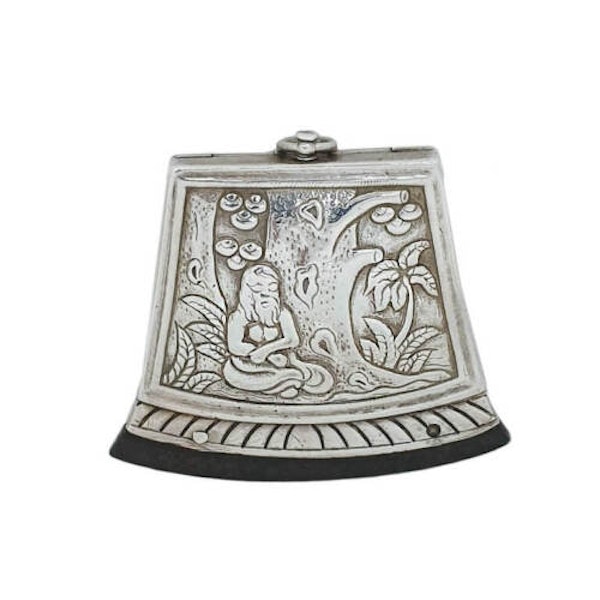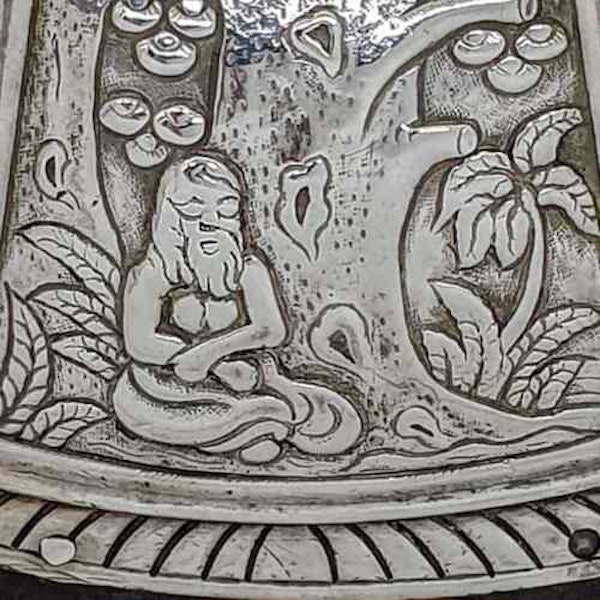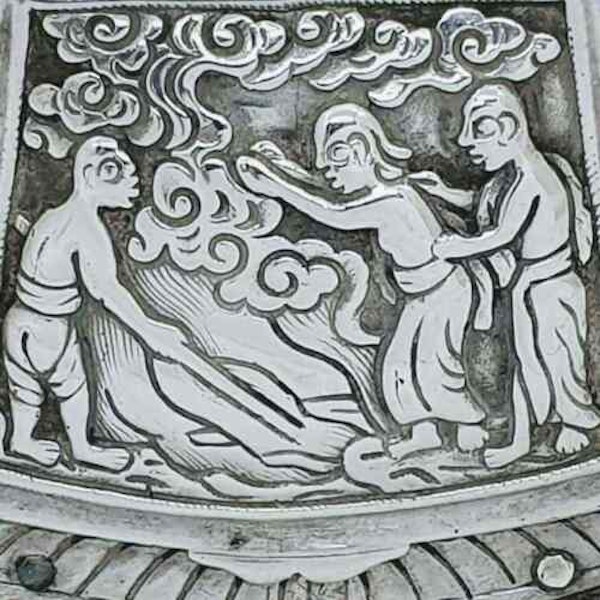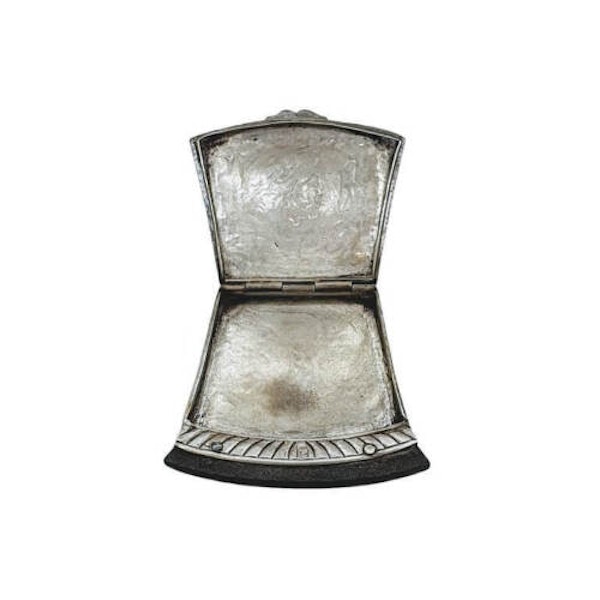Antique Indian Silver Tinderbox With Flint, Calcutta, India – 1800/50
Antique Indian Silver Tinderbox With Flint, Calcutta, India – 1800/50
£1,800.00
Description
In the days before matches were invented, a flint and steel were the fastest and most reliable way to start a fire and widely used. They were so important that they would be kept on the person at all times, often hung around the neck or from a belt. A tinder box and flint would have been an indispensable piece of equipment for anyone wishing to light a fire and an essential piece of kit for those serving in the military or traveling out of the cities in India prior to the arrival of fast and reliable forms of transportation from city to city, specifically the railways.
The box would be used to store the fine dry tinder which would be initially required to start a fire. Certain dried leaves, fungi, wood shavings or charred cloth were favourite tinder, whichever material was most convenient and highly combustible. Once the fire was built, the flint would be struck repeatedly on a piece of steel, commonly a knife, which would produce small sparks. These sparks would ignite a small pile of fine dry tinder which would be gently blown upon and fanned until a small flame was produced. At that stage, larger pieces of dry tinder would be introduced before using this bundle to set alight to the larger twigs and branches necessary for a good fire. A good fire gave warmth, allowed cooking and warded off predatory animals.
This antique Indian silver fire striker compendium comprises a box with a hinged lift up lid and a protruding silver thumbpiece to facilitate easy opening. Below this hangs a curved silver frame to hold the flint. The flint is in place and probably original. There is a sturdy ring to the top of the box which would accept a silver chain, leather thong or thick cord.
There are two repousse and chased panels to front and back, both feature designs after illustrations by Solvyns and both have a connection with fire. To the front is a copy of Solvyns portrait entitled ‘Paramhamsa, a Purum Hungse’. This was the name of a particular type of fakir who superstitious Hindus believed was a man who had descended from heaven and had lived for thousands of years without taking any nourishment. They believed that if this man was thrown into water or fire, he would suffer no fatal effect from either experience. The inspiration for the back is another Solvyns illustration entitled ‘Sahagamana, A Sho Hogomon, 3’ which shows a widow about to step onto the funeral pyre of her late husband.
‘When the Flemish artist Balthazar Solvyns arrived in Calcutta in 1791, the debate over sati (suttee) was just beginning as missionaries, amongst others, condemned official toleration of the "dreadful practice" and called for its suppression. Of all Hindu customs, none more fascinated--or appalled--the Europeans than "suttee," the practice of widow-burning. The term sati is Sanskrit for "virtuous woman," but it is used principally to refer to the faithful wife who "becomes sati" through self-immolation on the funeral pyre of her husband. Europeans erroneously took the word to mean the practice itself, and suttee, the European corruption, has become the conventional term for the wife's self-immolation. Solvyns uses neither suttee nor sati as terms in his description, but rather the Sanskrit word he spells phonetically from Bengali pronunciation. The practice by which the wife joins her husband in the flames and becomes sati is termed sahamarana, "dying together," also known as sahagamana--Solvyns's Shoho-Gomon--meaning "going together."
The practice was prevalent in Bengal in the eighteenth and early nineteenth centuries. Benoy Bhusan Roy, in 'Socioeconomic Impact of Sati in Bengal', writes that suttee was most frequent among Brahmins, but that the practice was found among the families of lower castes that had distinctive positions in wealth or property. Indeed, the possible increased frequency of suttee may have reflected an aspiration to higher social status among upwardly mobile sudra families. But, as official records in the early nineteenth century reveal, suttee was not limited to the more affluent. The practice was to be found among many castes and at every level of society.
Amongst European travelers in India during the late eighteenth and early nineteenth centuries, no description was complete without a reference to suttee--preferably with at least one eye-witness account! Pierre Sonnerat, who traveled in India in the 1770s, describes the practice and provides an engraving of an Indian woman going to be burned with the body of her husband. Another French traveler, Grandpre, writing of his experience in Bengal in 1789 and 1790, relates his own unsuccessful effort to rescue a beautiful young woman who was to become sati, and notes that the practice of suttee was particularly "horrible" in Bengal. Failed intervention was a frequent theme in European accounts, as in Thomas Twining's description of his thwarted effort to prevent a suttee some 60 miles outside Calcutta in 1792. Confirming accounts of restraints to prevent the woman's escape, Edward Thompson writes in Suttee that "Especially in Bengal, [the woman] was often bound to the corpse with cords, or both bodies were fastened down with long bamboo poles curving over them like a wooden coverlet, or weighted down by logs."
Most instances of suttee were described as "voluntary" acts of courage and devotion. But there were surely cases involving the use of force, drugs, or restraints. "An Account of a Woman burning herself, By an Officer," appeared in the Calcutta Gazette in 1785, one of various instances of suttee reported periodically in Calcutta newspapers. The observer describes the woman as likely under the influence of bhang or opium but otherwise "unruffled." After she was lifted upon the pyre, she "laid herself down by her deceased husband, with her arms about his neck. Two people immediately passed a rope twice across the bodies, and fastened it so tight to the stakes that it would have effectually prevented her from rising had she attempted."
The Reverend William Ward, a Baptist missionary at Serampore, near Calcutta, and a contemporary of Solvyns, recounts his own witness of the practice (which he terms suhu-murunu ), as well as reported instances in the area of Calcutta. William Carey, the famed author of the Dictionary of the Bengali Language and Ward's colleague at the Serampore Mission, undertook a census of suttees in 1803 and counted 438 that had reportedly taken place that year, within a thirty mile radius of Calcutta.
In contrast to the expressions of horror in most accounts, an American merchant, Benjamin Crowninshield, described the suttee he witnessed while in Calcutta in 1789 with "extraordinary detail" and "great sensitivity." In his ship's log, he concluded his sober account: "Whether it is right or wrong, I leave it for other people to determine. . . . [I]t appeared very solemn to me. I did not think it was in the power of a human person to meet death in such a manner." Similarly, Maria Graham, in her Letters on India, published in l8l4, wrote sympathetically and without judgment of the practice--particularly remarkable at a time when European missionaries and Indian reformers were mounting their campaign against suttee.
Within the city of Calcutta, under the jurisdiction of British law, suttee had been prohibited since 1798, but outside of Calcutta, the "dreadful practice" flourished in Bengal, some said, in epidemic proportions. As the debate over widow-burning intensified, officials took steps to suppress this practice. In 1812, a distinction was made between "legal" (voluntary) and "illegal" (involuntary) suttee. Its complete abolition came under Lord William Bentinck through Regulation XVII of the Bengal Code, December 4, 1829, declaring ‘the practice of suttee, whether voluntary or not, illegal and punishable by the criminal courts.’ (Hardgrave)
Frans Balthazar Solvyns (1760-1824) was an artist who was born in Antwerp in 1760 and later studied painting at the Antwerp Academy. In 1791 he came to India to seek his fortune as an artist but initially struggled to make an impact and subsisted by undertaking a range of part-time jobs. Noting the British interest in the diverse and exuberant Indian culture, he soon became fascinated by the Indian culture and people himself and started to learn Hindu and Sanskrit. Encouraged by Sir William Jones, founder of the Royal Asiatic Society in Calcutta, he embarked on an ambitious project to produce "250 coloured etchings descriptive of the manners, customs, character, dress and religious customs of the Hindoos".
Solvyns work was pioneering and provides us with much historical information today. “He began drawing his subjects from life, which included men and women of every possible caste or calling ranging from high-caste Brahmins to milk-women and sweepers. He portrayed many servants carrying out their specific duties within European households in Calcutta, such as a Sarkar, Hooka-bardar, Abdar etc. He also drew pictures of the colourful Indian festivals, the ascetics and mendicants who roamed about in the towns and villages, various forms of transport, including boats on the river, different kinds of pipes for smoking and a variety of musical instruments.” His drawings were first published in Calcutta in 1799.
The silver is stamped with the letter ‘P’, and dates between the years 1800 and 1850. One school of thought believes that these boxes were made in China for export to the Indian market whilst the other believes that they were actually made by Chinese silversmiths working in Calcutta and it is known that many fine Chinese craftsmen were working in Calcutta during the first half of the 19th century.
| item details | |
|---|---|
| Origin | Asian |
| Period | 19th Century |
| Style | Other |
| Condition | Excellent |
| Dimensions | Dimensions:- Height 4 cms; Width 5 cms |
| Diameter | Weight:- 34 grams |
Product REF: 10034












